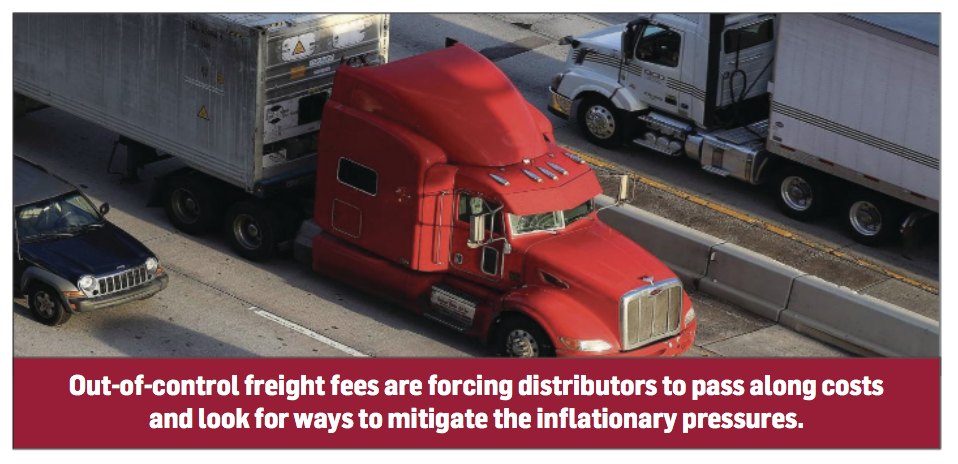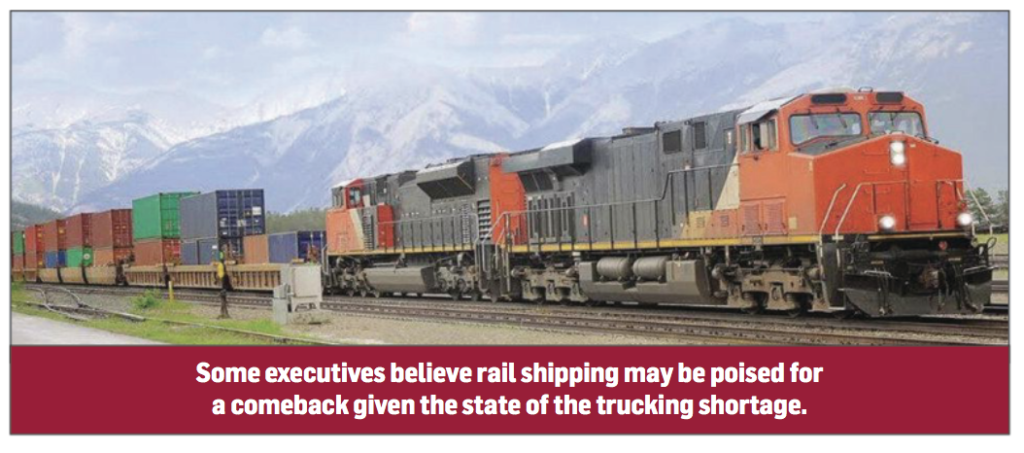October 29/November 5, 2018: Volume 34, Issue 10
By Ken Ryan
 A steep rise in freight costs exacerbated by factors such as a shortage of drivers, government mandates, tariffs on Chinese imports and a stronger economy has wreaked havoc on the flooring distribution industry.
A steep rise in freight costs exacerbated by factors such as a shortage of drivers, government mandates, tariffs on Chinese imports and a stronger economy has wreaked havoc on the flooring distribution industry.
With freight inflation so dramatic, many distributors have no choice but to pass along the increases. At the same time, they are looking for ways to minimize risk by consolidating routes, using rail to bring in bulk items and turning to new technologies to be more efficient.
It cannot be overestimated how important freight trucks are to the U.S. economy. According to the American Trucking Association (ATA), freight trucks represent 70.9% of the nation’s freight by tonnage and 81.5% of the nation’s freight by cost spent. Wages continue to rise for America’s truckers as the trucking industry contends with driver shortages coupled with an increased demand for shipping services. The ATA estimates the U.S. is already short roughly 60,000 truckers, and within the next eight years the shortage is predicted to reach 174,000. As a result, distributors are forced to pay higher wages for truckers at a time when fuel has been rising.
At Mesa, Ariz.-based Longust Distributing, LLC, with multi-state locations throughout the Southwest, transportation costs are rising every month, according to Drew Mittelstaedt, president and partner. The increases are particularly acute in California, he said. “Wages, fuel, LTL (less than truckload), ocean—everything transportation related is going up. It’s also affecting delivery times from our vendors due to the shortage of drivers,” said Mittelstaedt.
In response to the trucker shortage and subsequent inflationary pressures, Mittelstaedt said Longust has taken steps to consolidate routes, arrange cooperative runs with other non-flooring distributors, modestly increase its freight rates, use rail to bring bulk items in where possible and work to ship more items direct. “I remain hopeful that it will reduce the number of distributors and suppliers that pretend to offer free freight,” Mittelstaedt said.
Outbound freight charges have had a deleterious effect on Jaeckle Distributing’s business, according to the company. Through 10 months of its fiscal year, the Madison, Wis.-based company’s outbound freight costs are up 34.2%, which is significantly greater than its percentage increase in business, according to Bill Simonson, COO of Jaeckle.
“We reacted to this by recently passing along a fair delivery charge increase,” said Simonson. “We are also in the process of rebidding all of our LTL carrier’s pricing and looking at opportunities with new carriers. We do this once a year and it normally yields us a 5% savings. However, this year I don’t expect to see a savings. Unfortunately, I am hearing some businesses are seeing 15% to 20% increases.”
There is no short-term fix to the higher freight costs, which is being magnified by the strong economy. Studies have shown there are fewer drivers entering the job market as fewer young adults want to pursue that particular career path. Furthermore, baby boomers are retiring, and that generation holds a good portion of the overall driver positions. The upshot? Fewer drivers to move freight. The ones that are staying are seeing huge pay hikes and bonuses. A recent study by the ATA of more than 100,000 employees and contractors showed the median salary of a U.S. truckload driver increased about 15% to $53,000 from 2013 to 2017. Pay for a private fleet trucker jumped almost 18% to more than $86,000. That outpaces the 10% average hourly earnings for all private workers in the U.S. during the same period, according to the Bureau of Labor Statistics.
Impact of ELD
The new electronic logging device (ELD) mandate that took effect in 2018 threatens to squeeze trucking capacity even more. This Congressionally mandated rule is intended to help create a safer work environment for drivers (truckers are limited to 11 hours a day on the road), and make it easier and faster to accurately track, manage and share records of duty status data. An ELD synchronizes with a vehicle engine to automatically record driving time for easier, more accurate hours of service recording. Jaeckle has been operating with electronic logs since 2008, so the ELD mandate hasn’t impacted how it operates. However, it has impacted other carriers by adding another layer of complexity for those new to the mandate.
 Prior to ELD, over-the-road drivers had some gray area in which to work. The new rules have cut into drivers’ revenue, prompting many self-employed over-the-road drivers to shut down their trucks and work for someone else or leave the industry entirely. By some estimates 10% to 15% of drivers left the industry because they did not want to or could not afford to comply with the electronic logs. “We recently hired a self-employed driver who couldn’t justify driving for himself anymore with the constraints put on him with the ELD mandate, so he came to work for us instead,” Jaeckle’s Simonson said. “Carriers can no longer haul freight as effectively as they did previously due to the mandate.”
Prior to ELD, over-the-road drivers had some gray area in which to work. The new rules have cut into drivers’ revenue, prompting many self-employed over-the-road drivers to shut down their trucks and work for someone else or leave the industry entirely. By some estimates 10% to 15% of drivers left the industry because they did not want to or could not afford to comply with the electronic logs. “We recently hired a self-employed driver who couldn’t justify driving for himself anymore with the constraints put on him with the ELD mandate, so he came to work for us instead,” Jaeckle’s Simonson said. “Carriers can no longer haul freight as effectively as they did previously due to the mandate.”
For many distributors with a large territory, freight increases have impacted factory direct shipments to flooring dealers and their job sites.
Jacksonville, Fla.-based Cain & Bultman, which covers the state of Florida and parts of Georgia, for example, absorbed an additional 47% on freight cost. “We were advised one day that the increase was immediate, causing major pricing problems on sold jobs that were on order waiting to be shipped,” Buddy Faircloth, president, told FCNews. “It has cost our company 50% of our gross margin in the direct-ship portion of our business. The direct side of our business is high volume, very low gross business to start with…and then being hit with a 50% loss of margin really hurts. There is nothing we can do if we want the business.”
As with others, Haines has certainly endured cost increases, particularly in the transportation arena where ELD mandates have caused a significant contraction of its capacity. Haines, the industry’s largest wholesaler, has worked over the past three years to find ways around what was then a projected increase in these costs.
“As this forecast has become reality, these plans are helping us,” said Michael Barrett, Haines president and CEO.
The wholesaler has worked with companies such as JB Hunt and CH Robinson to help ensure its costs are kept under control. “On the delivery side, we have a multi-year contract with moderate escalators that has aided us in managing through the cost component of transportation,” Barrett added. “Companies like Hunt also have much greater capability to ensure our driver pool is maintained through their capabilities in sourcing and hiring drivers. On the inbound freight side, the positive impact that CH Robinson provides is the ability to find capacity needed to move freight. We are seeing costs escalate here as well, and we continue to monitor to ensure we can achieve our goals.”
Jaeckle’s Simonson said the distribution industry in the past has been structured around affordable flat-rate deliveries and with the expectation that distributors will take on the burden of subsidizing freight. “What I see for the future is a movement toward a more realistic and fair understanding of what true freight charges are, and a more shared approach to burdening those costs.”
